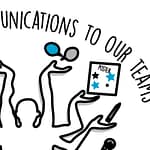It’s not always widely understood or even much discussed, but everything that happens in our organisations is the result of the decisions, desires, capabilities and priorities of our leaders and managers.
Let me elaborate. Those at the top set the strategy. They define the vision, mission and values. They create the top-level plans and objectives. They shape the way things are organised and the major processes. They set policy and define available resources. They shape the culture and set the tone.
Those in the middle give some input to this and then translate it all for their area of influence. They plan to deliver what they’ve been asked to deliver and are often rewarded and incentivised – and certainly judged – on how well they do so.
Those at the front line deploy their people to make it all happen as defined – and to keep their ‘bosses’ happy.
…and all of them measure and monitor progress towards these aims through a web of agreed indicators, targets and metrics.
So far so good, right?
All sounds very business-like, systematic and clear.
However, there are a few rather fat flies in that particular ointment.
In the two previous shows I spoke about the need to build better organisations doing better work with better outcomes to create a better world and that the primary purpose of an organisation – even in commercial business – should not be to make profits or provide returns to shareholders. I proposed that to achieve this, we must first transform our leaders & managers.
If you think about those things and then about the leadership & management process I just described, it’s not hard to see some of the difficulties we therefore face.
Those decisions, priorities, objectives, plans and measures that shape every department, process, goal and team tend to be heavily biased and skewed towards delivering financial outcomes such as profit/surplus, ROI, market share and efficiency/productivity and tend to be focused on the needs of one or two stakeholders rather than them all.
As a consequence, much of what passes for management in our organisations is actually often about ensuring the achievement of targets, controlling costs, enforcing compliance with rules and regulations – and about preventing any departure from the prescribed path that has been ordained.
Now, I appreciate I’m probably making it sound more draconian and constrained than it might actually feel in your organisation – but take a look around you. How much of what is happening is directed and regulated by those top-level decisions, priorities, objectives, rules and edicts? How much freedom of thought, of action, of ideas – how much wiggle-room – is there really?
If, after a good hard look, you can honestly say that there’s lots – then that’s great and I’m very glad to hear it – and perhaps your organisation is an exemplar of the future state I think we should be trying to build. But for most…? Probably not so much.
Just in case anyone thinks I’m spouting trendy lefty politics here, rest assured I’m not.
I’m very much an agnostic when it comes to politics and tend towards the moderate centre rather than either extreme. I don’t read the Guardian. I’m not in HR. I’m not even a Vegan.
I don’t live in London or the South East either – I live in a small rural village in Norfolk.
My views and observations on all of this come from around 40 years at senior level, 35 years of academic and practitioner study and reflection – and a lifetime of developing leaders at every level, including myself.
So where do all these observations leave us?
A lot of the challenge for leadership comes down, in my view, to what we tend to think a leader & manager’s job is.
In my experience, it can often be boiled down to a few things:
- Keeping everything under control and on-message
- Supervising and monitoring people and outputs
- Being responsible so that top management have someone to speak to (or blame) about performance or when something goes wrong
- Putting out fires
Perhaps this is one key reason that we don’t think managers really need to be professionally trained and qualified? We simply don’t take the role seriously enough or recognise the complex nature and web of skills, aptitudes and capabilities required to do it well.
Add to this that many very capable people end up in management roles not because they want to, or even because they have the skills and aptitudes necessary, but because it’s the only way to earn more money and make progress in their career. The Peter Principle – defined in a book by Laurence Peter more than 50 years ago – summed this up when he said that people ‘rise to their level of incompetence’ – by which he meant that success in a role leads to promotion, possibly several times, until the manager reaches the level where they can no longer perform well – so they stay there. Let that thought settle for a minute or two.
Finally, we tend to recruit managers and promote people into management based on outmoded ideas of the ‘blueprint’ and on irrelevant indicators. Toughness, dynamism, drive, laser focus on results, refusal to accept underperformance, a track record of achievement – these are often what gets someone promoted into leadership. Unfortunately, those things aren’t what we need anymore, even if they were before (which I also dispute).
Tomorrow’s leader & manager needs to be a mentor, a coach, a supporter, a resource gatherer, an enabler – someone who can inspire, engage, enthuse and develop their people.
The days of the heroic (typically white, middle-class and male) figure, overseer and taskmaster are largely consigned to history. Just no-one seems to have told many organisations that, so the blueprint often remains and we continue to select too many narcissists, bullies and those driven by career advancement and self-interest. We need diversity and in every sense – gender, ethnicity, social background, sexual identity, age, thinking style, specialism, ability/disability – and some have made strides. Many have not.
In simple terms, organisations have understood for decades that supervisors and team-leaders needed training (though admittedly often in health & safety, employment law and other things that might stop them from getting the organisation into trouble) but have steadfastly refused to perceive the same need at higher levels. More than 75% of UK leaders and managers remain unqualified (CMI 2019) – and those that are qualified remain heavily skewed towards the lower end of the management ladder. We think instead that its fine for them to be trained and qualified in something else… as though a dentist should be allowed to fly a plane.
As 2 of the 4 enablers of Engagement defined in the MacLeod report indicate – it relies on the right Strategic Narrative (purpose, vision, goals) from the top and Engaging Managers at every level. That requires all our leaders & managers to be of the ‘new’ type I described earlier. How’s that going, do you think?
Two things I think are a great place to start:
- An audit of your existing leaders & managers – are they qualified to manage at the level they hold? Do they exhibit the qualities of an ‘engaging manager’?
- A professional leadership qualification initiative – which establishes the level of professional development/qualification that any new leader and manager must achieve to reach each level – and gives a career ladder for future leaders & managers
It certainly won’t be enough on its own. But it’ll establish a critical baseline and a way forwards that could lead to a very different tomorrow.
For all of us.
Author: Nigel Girling, Senior Consultant, Inspirational Development Group
Listen to Nigel’s latest appearance on our radio podcast here.




